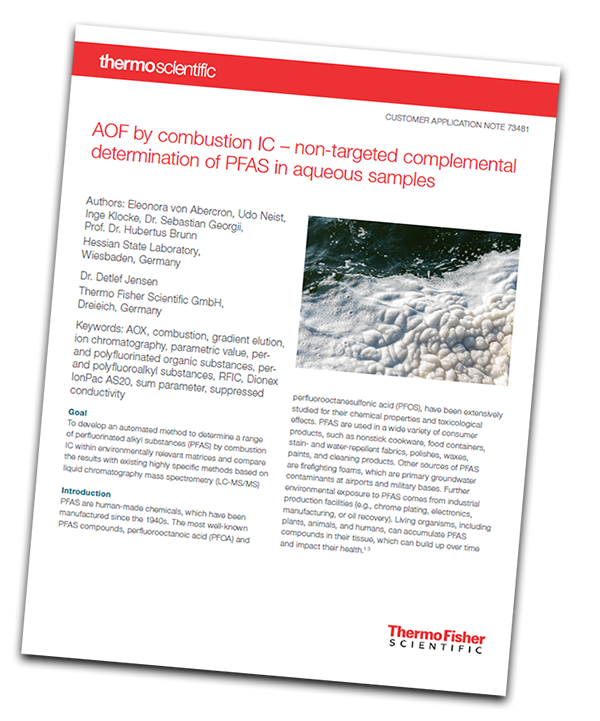This application note demonstrates an automated method to determine a range of perfluorinated alkyl substances (PFAS) by combustion IC within environmentally relevant matrices and compare results with existing highly specific methods based on LC-MS/MS.
 Introduction
Introduction
PFAS are human-made chemicals, which have been manufactured since the 1940s. The most well-known PFAS compounds, perfluorooctanoic acid (PFOA) and perfluorooctanesulfonic acid (PFOS), have been extensively studied for their chemical properties and toxicological effects. PFAS are used in a wide variety of consumer products, such as nonstick cookware, food containers, stain- and water-repellent fabrics, polishes, waxes, paints, and cleaning products. Other sources of PFAS are firefighting foams, which are primary groundwater contaminants at airports and military bases. Further environmental exposure to PFAS comes from industrial production facilities (e.g., chrome plating, electronics, manufacturing, or oil recovery). Living organisms, including plants, animals, and humans, can accumulate PFAS compounds in their tissue, which can build up over time and impact their health.
Several national and international standardization and regulatory bodies have developed methods specifically for the determination of PFAS in aqueous samples. These methods are mostly based on solid-phase extraction (SPE) followed by LC-MS/MS detection for only a select number of PFAS.
This work focuses on PFAS, and the adsorbable organically bound fluorine (AOF). The use of this technique is well documented for the determination of other adsorbable organic halogen-containing components (AOX).
Experimental
Full details of the experimental conditions can be found by downloading the application note.
Results and Discussion
Calibration, linearity, and analytical performance
The linearity of the calibration function within the range of 2 to 500 μg/L fluoride was evaluated according to the “point to point-slope“ approach described in DIN 38402-51. Before each sequence, the system was calibrated for the range between 2 to 100 μg/L fluoride. At a minimum, a 5-point external standard calibration was carried out for fluoride. The calibration solutions were prepared from the individual standard stock solution through successive dilution.
Conclusion
The described AOF approach extends the analytical toolset to determine PFAS in environmental samples, such as surface water, groundwater, and wastewater. While LC-MS/MS and gas chromatography tandem mass spectrometry (GC-MS/MS)-methods use a specified set of PFAS for the evaluation, the adsorption process for the AOF method ensures the extraction and determination of more components—PFAS and other fluorinated compounds—than the previously mentioned approaches.
